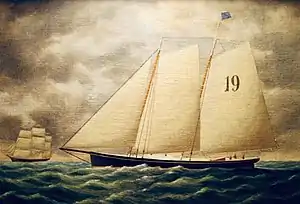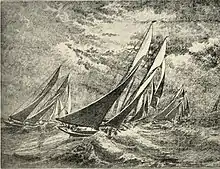Jacob A. Westervelt (pilot boat)
Jacob A. Westervelt was a 19th-century New York pilot boat designed by naval architect John W. Griffiths and built by Jacob Aaron Westervelt. She was one of the fastest pilot-boats in the fleet. In 1858, while attempting to board the British steamer Saxonia she was fatally run into and sunk, outside of Sandy Hook.
 Pilot Boat Jacob A. Westervelt, No. 19. | |
| History | |
|---|---|
| Name: | Jacob A. Westervelt |
| Namesake: | Jacob Aaron Westervelt, shipbuilder |
| Owner: | New York pilots |
| Operator: | John O’Keefe |
| Builder: | Daniel Westervelt of New York City |
| Cost: | $8,000 |
| Launched: | February 4, 1854 |
| Completed: | December 1853 |
| Out of service: | 20 April 1858 |
| Homeport: | New York |
| Status: | Sank |
| General characteristics | |
| Class and type: | Schooner |
| Displacement: | 100 tons TM[1] |
| Length: | 87 ft 0 in (26.52 m)[2] |
| Propulsion: | sails |
| Sail plan: | Schooner-rigged |
Construction and service
The pilot-boat, Jacob A. Westervelt, No. 19, was designed by John W. Griffiths, who wrote a Treatise on Marine and Naval Architecture. In the Westervelt, Griffiths cut out the traditional drag of the keel, that produced a fast shoal-draught boat.[2] She was built in December 1853 by Aaron J. Westervelt, of the Jacob A. Westervelt Sons & Company for Sullivan & Pratt and the New York pilots: John O’Keefe, John E. Johnson, Charles L. McCummisky, Peter McEnany, Eugene Sullivan, Daniel Baker and William Smith.[3] She was launched on February 4, 1854 for a company of New York Pilots.[1][4]
On May 26, 1857, John L. Roff, boatkeeper on the Jacob A. Westervelt, No. 9, picked up a drowned man at Coney Island and brought the body to the Brooklyn Coroner.[5]
Out of service
The Westervelt spotted the British screw steamer Saxonia on Tuesday morning, April 20, 1858, 270 miles east of Sandy Hook. While attempting to board her, the Westervelt was struck by the steamer. The men on the Westervelt were able to climb the robes thrown over the steamer's bow. Her captain, John O’Keefe, went missing and later reported as drowned. The pilots on board the Westervelt were: John E. Johnson, John Wright, John Hines, Charles L. McCummisky, and Peter McEnany.[2]:p82[6][7][4] On, April 21, 1858, Maurice O'Keefe placed an ad giving a reward to any person recovering the body of her husband, John O'Keefe.[8]
Edmund Blunt

New York pilot-boat Edmund Blunt, No. 2, was launched on 18 August 1858, by Edward F. Williams to replace the Jacob L. Westervelt, that was run down by the Bremen steamer Saxonia on 21 April 1857.[9]
She was 56-tons (121-tons carpenter's measurement), 84 feet in length, 20 feet beam, and 8 feet hold.[10]
She was one of only twenty-one New York and New Jersey pilot boats listed in 1860. The Blunt was registered with the Record of American and Foreign Shipping from 1876 to 1900 to Captain Josiah Johnson and owned by New York Pilots.[11]
On 9 October 1873, the Edmund Blunt was one of the boats that participated in the Cap May Regatta, which was a race from Owl's Head Point around to Cape May Lighthouse in New Jersey, and back to the Sandy hook Lightship. She was listed as No. 21 in the race.[12] Pilot boats Mary A. Williams, William H. Bateman and Edmund Blunt raced and competed for honors in May 1890.
Pilot-boat Edmund Blunt, No. 2, went ashore in the Great Blizzard of 1888 on the Long Island coast. Captain Abraham Jones belonged to the pilot-boat and had been a pilot since 1851.[13][6]:p54
On February 1, 1896, the New York Pilots discarded sixteen sailboats and moved them to the Erie Basin in Brooklyn. They were replaced with steam pilot boats. The Edmund Blunt, was sold for $2,000.[14] The Blunt went on to do ferry duty between the islands of the West Indies.[6]:p54
References
- "New York Yards. Jacob A. Westervelt & Co. Launched". The New York Herald. New York, New York. 29 Jun 1854. p. 2. Retrieved 11 Nov 2020.
- Cunliffe, Tom (2001). Pilots, The World Of Pilotage Under Sail and Oar. Brooklin, Maine: WoodenBoat. p. 77. ISBN 9780937822692.
- "The City Yards. Jacob A. Westervelt & Co. On the Stocks". The New York Herald. New York, New York. 29 Dec 1853. p. 2. Retrieved 11 Nov 2020.
- "The Pilot-bat Westervelt Run Down By A Steamship-One of the Pilots Drowned". New-York Tribune. New York, New York. 21 April 1858. Retrieved 1 September 2020.
- "A Drowned Man". The New York Tribune. New York, New York. 26 May 1857. p. 7. Retrieved 11 Nov 2020 – via Newspapers.com.
- Allen, Edward L. (1922). Pilot Lore From sail to Steam. The United New York and New Jersey Sandy Hook Pilots Benevolent Associations. p. 12.
- Russell, Charles Edward (1929). From Sandy Hook to 62°. New York: Century Co. p. 114. OCLC 3804485.
- "$100 REWARD – TO MASTERS OF PILOT BOATS, FISHING SMACKS". New York Herald. New York, New York. 23 Apr 1858. Retrieved 12 Nov 2020 – via newspaperarchive.com.
- "Launched". The Brooklyn Daily Eagle. Brooklyn, New York. 20 August 1858. p. 3. Retrieved 11 August 2020 – via Newspapers.com.
- "Launch". Brooklyn Evening Star. Brooklyn, New York. 11 August 1858. p. 3. Retrieved 11 August 2020 – via Newspapers.com.
- "Record of American and Foreign Shipping 1876". Mystic Seaport Museum. New York. Retrieved 2020-11-12.
- Loubat, Joseph Florimond (1887). A yachtsman's scrap book: or, The ups and downs of yacht racing. New York: Brentano Brothers. p. 42.
- "Staten Island". The New York Times. New York, New York. 20 April 1882. Retrieved 11 August 2020 – via Newspapers.com.
- "Not Up To Date. Why New York Pilots Are Discarding Sailboats. They Must Catch Steamers". The Standard Union. Brooklyn, New York. 1896-02-01. p. 7. Retrieved 2020-09-08 – via Newspapers.com.